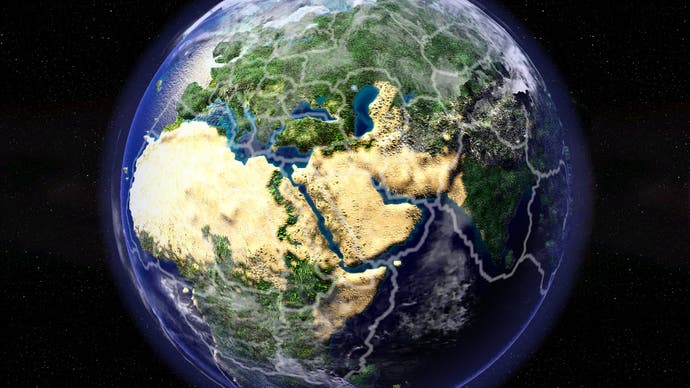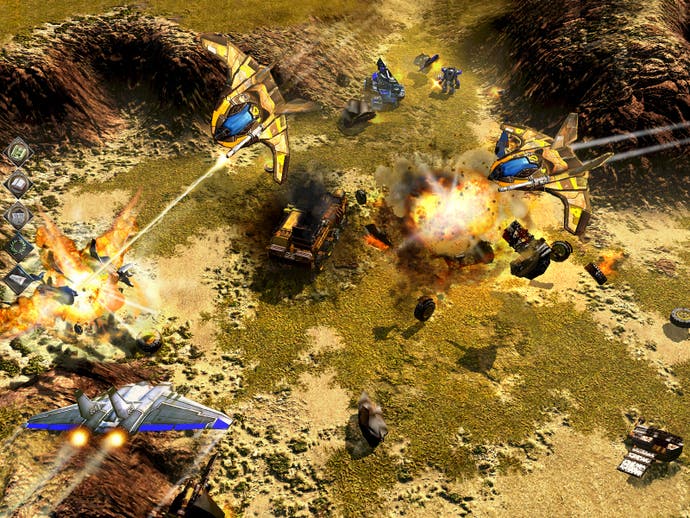Empire Earth III
The sun never sets.
Ironically, perhaps, for games sporting such an ambitious title - roll "Empire Earth" around on your tongue a bit, and then come and tell me it doesn't simply drip with grandeur - this is a series that's always been overshadowed somewhat by its rivals.
Despite uniformly good reviews for the first game, and good-but-not-quite-as-good reviews for its sequel, Mad Doc's series has never quite recovered from the fact that Age of Empires was there first - or that Rise of Nations did broadly the same thing, but in a more accessible and more heavily promoted way.
With the third iteration of the series, Mad Doc doesn't seem keen to repeat its previous performances as bridesmaid, rather than bride. Acknowledging that the second game was a bit too intricate and fiddly for many players, the team has radically overhauled the Empire Earth formula - simplifying many features, focusing on accessibility, and completely changing whole swathes of the game.
The Roaming Empire

The basic premise of Empire Earth remains the same as before, and it's every bit as compelling as it has always been. You command a civilisation, starting from the very earliest reaches of history and advancing through research and warfare right up to modern times and beyond.
In the single-player campaign, this means gradually advancing through the ages (or Epics, in EE3 parlance), with several battles being fought in each age until eventually you're battering your opponent with big stompy mecha, lasers and nuclear missiles. In skirmish mode or multiplayer, you advance much more swiftly - going from the Stone Age to the Big Bloody Robot Age in the space of a single battle.
The most blatant addition to the formula in EE3 is that it has sprouted a whole new game mode which overlies the entire single-player experience, a turn-based world domination affair which sees you gradually branching out from your starting region to take over the entire planet.
Drawing inspiration from both the Medieval series and Civilization, the world domination mode looks like it could turn out to be satisfyingly complex. Rather than simply being used to move armies around, the turn-based map allows you to choose whether each province you conquer is a Military, Commercial, Imperial or Research province - a choice which affects the kind of units or resources produced, as well as your progress through the tech tree.

Moreover, you can upgrade territories in various ways - one obvious example we saw being the addition of a road network to a province, which reduces the travel time for armies across that province, and makes your forces far more mobile. The game also plays with the concept of spies, which can be used to report info on your enemies, but we didn't get to see much detail on the working of this mechanism in our demo session.
Once each turn on the world domination map is complete, you then get a chance to resolve all the battles you started in that turn in real-time mode. It's here that another major departure from Empire Earth's previous design becomes apparent. Whereas previously the game's playable civilisations were broadly analagous, with minor differences in terms of special units or production strengths, EE3 has opted instead for the Starcraft model - with three civilisations whose entire workings are entirely different from one another.
The three civilisations on offer here are the West, the Middle East and the Far East. Right from the outset, they're very different. Only the West has builder units, for example; the Middle East forces construct their buildings as mobile units, which can deploy and then pack up again as required, while the Far East forces can build structures using any units at all.
As you progress, the differences become even more marked. The West is, perhaps, the most generic RTS race on offer, and once you go past the present day it goes down the robots-and-lasers route. The Middle East, meanwhile, adopts a somewhat Mad Max aesthetic, and its technologies are focused on camouflage, cloaking and ambushing strategies - while the Far East is effectively the Zerg race of this game, with vast numbers of cheap and plentiful bio-engineered units.
A Warning From History

The chances are that Empire Earth III will live or die by how well the team at Mad Doc have managed to balance out those three races, and that's one aspect we're really looking forward to getting our teeth into when we see final code. However, there are plenty of other interesting tweaks to the formula on display here as well.
One example of a feature we like the sound of is the use of research points to fire various super-weapons - such as the impressive nukes or the "black hole gun" wielded by the Western forces. In effect, this means that it's important to keep your research facilities running even after you've advanced to the top of the technology tree. The black hole gun (which fires off a very pretty and impressive physics-driven effect on the battlefield) takes 25 research points to fire - by way of comparison, a mere 100 research points will advance you from Ancient to Medieval times.
Which leads us on to another significant change in the game - the simplification of the advancement system, which now only has five "Epics" (ages) to move through. That's vastly less than the previous games, a decision which has been taken in order to make sure that each Epic is very distinct from the previous one. It's a logical decision, Mad Doc argues, because there were only about five Epic changes that mattered in the previous games anyway - such as the change from horses to tanks, or from swords to muskets, with the other minor Epic changes being there largely as padding.
It's a perfectly sound piece of reasoning, and it demonstrates a laudable willingness on Mad Doc's part to progress its game design through judicious simplification - rather than pursuing the path of adding layers of complexity with each new version of the game. Similarly, the resource structure has been boiled down to its most basic level - you now only have two resources, Wealth and Raw Materials, which should allow players to focus on managing battle strategy rather than resource collection.

Of course, no real-time strategy game would be complete without its multiplayer mode - and while we like some of the ideas Mad Doc has in mind for this, we do suspect that the lack of a multiplayer World Domination mode is going to be a bit disappointing. Multiplayer games are resolutely designed around single battles, with the turn-based option being for single-player mode only. It's a situation the developer hopes to resolve with a patch down the line, but they're promising nothing - and it won't be in there for launch.
On the other hand, you do get a couple of promising options to make up for it. The game ships with a map editor, which should hopefully stoke up an active map-making community - and, interestingly, there's also a civilisation editor, allowing you to build custom civilisations by allocating points on specific abilities. Between them, these should make for plenty of interesting variety in multiplayer, at the very least.
It's great to see Mad Doc taking a new direction, rather than simply turning out an evolutionary sequel. Whether it'll finally take the series out of the shadows of its peers remains to be seen, but it's certainly looking promising - and we're looking forward to getting to grips with the full game ahead of its 16th November release.

